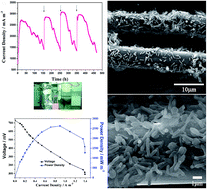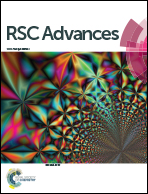A high performance xylose microbial fuel cell enabled by Ochrobactrum sp. 575 cells†
Abstract
A new strain, Ochrobactrum sp. 575, is applied as an anodic biocatalyst in a xylose MFC. After evolution under electrochemical tension in MFCs, Ochrobactrum sp. 575 can deliver a maximum power density of 2625 mW m−3, which is 20 times higher than that reported for similar MFCs. The slight increase in pH with the operation progress of Ochrobactrum sp. 575 MFC indicates proton involvement in the anode electrochemical reaction. For the first time, fumaric acid, an important intermediate in the succinate oxidation respiratory chain of gram-negative strains is discovered in the anodic supernatant of the MFC. This indicates that the process of xylose digestion with Ochrobactrum sp. 575 depends on the succinate oxidation respiratory chain, which is quite different from the traditional NADH oxidation respiratory chain in other electroactive bacterial strains. The significant improvement in the MFC power density is likely to be attributed to fumaric acid generated by bacteria cells as an electron mediator to facilitate electron transfer during the discharging process.

- This article is part of the themed collection: Materials for Energy storage

 Please wait while we load your content...
Please wait while we load your content...